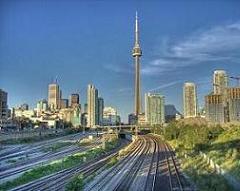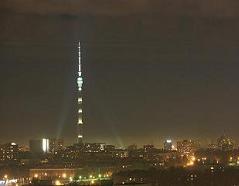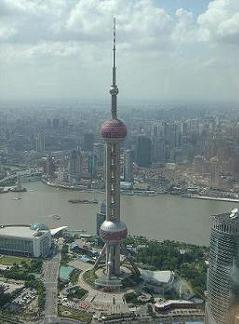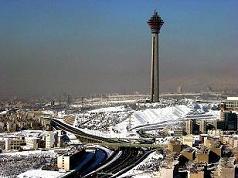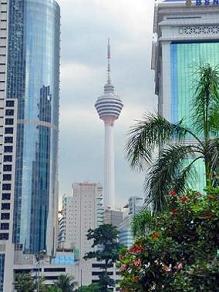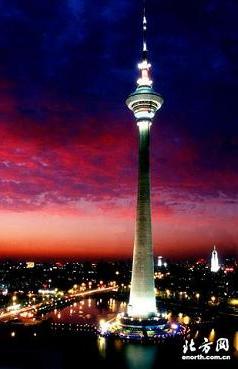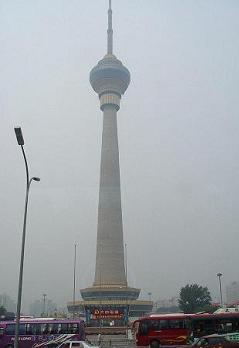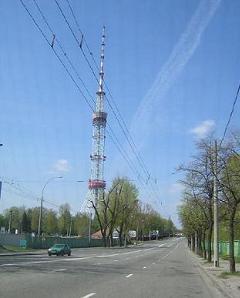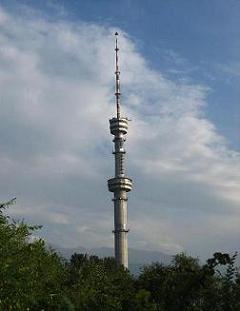TT Ziggurat and the 13 Tallest Towers
50 miles south of present day Baghdad in the province of Babil one can find the ruins of a city once called Babylon which in early Akkadian means "God's Gateway". It was here almost 4,000 years ago that the Babylonians built a seven story ziggurat or temple tower called Etemenanki.
It is likely that this is the edifice referred to in the Bible as the Tower of Babel. The early Israelites must have noticed how all the languages of the time had similar roots and so speculated that at one time the world had one common language. One of the Bible's early scribes with a penchant for puns, saw that the name for the city was Babel and the Hebrew word Babel meant confusion, constructed a story to explain why the languages of the world diverged.
According to Genesis 11:1-9, after the deluge, mankind left the ark and settled in the land of Shinar where they tried to build a tower whose pinnacle might touch Heaven. This arrogant attempt to meet God so angered Him that he made each person in the project speak a different language killing the construction project and eventually scattering the peoples across the globe.
But mankind still has not stopped trying to build towers that reach into the heavens. Here are the 13 tallest towers in the world: (As always click on images for larger view)
2) Ostankino Tower is a free-standing television and radio tower in Moscow, Russia. Standing 540 metres (1772 feet) in height. Designed by Nikolai Nikitin, as of 2005, it remains the highest freestanding structure in Eurasia.
The tower's construction began in 1963 and was completed in 1967. It held the record for the tallest free-standing structure in the world for one decade, until the CN Tower was built in Toronto, Canada (1976).
3) The Oriental Pearl Tower (Chinese: 东方明珠塔; pinyin: Dōngfāng Míngzhūtǎ) is a TV tower in Shanghai, China. It is located at the tip of Lujiazui in the Pudong district, by the side of Huangpu River, opposite The Bund of Shanghai and modeled after the Fernsehturm Tower in Berlin.
It was designed by Jia Huan Cheng of the Shanghai Modern Architectural Design Co. Ltd. Construction began in 1991 and the tower was completed in 1995. At 468 m (1,535 feet) high, it is the tallest tower in Asia, and the third tallest tower in the world.
4) Borj-e Milad (Milad Tower, Persian: برج میلاد ) is the tallest tower in Iran. Built in the Gisha district of Tehran, it stands 435 meters (1427 ft) high from base to tip of the antenna. The head consists of a large pod with 12 floors, the roof of which is at 315 m (1034 ft). Below this is a staircase and elevators to reach the area.
Milad tower is part of The Tehran International Trade and Convention Center. Completed 2007, the project includes the Milad telecommunication tower offering restaurants at the top with spectacular views of Tehran, a five-star hotel, a convention center, a world trade center, and an IT park.
5) The Kuala Lumpur Tower (officially known as Menara Kuala Lumpur; referred later as KL Tower) is located in Kuala Lumpur, Malaysia and was built in 1995. Used for communication purposes it features an antenna that reaches 421 m (1,381 ft), which currently makes it the fifth tallest tower in the world. The roof of the pod is at 335 m (1,099 ft). The rest of the tower below has a stairwell and an elevator to reach the upper area, which also contains a revolving restaurant, providing diners a beautiful view of the city. Races are organised yearly where participants race up the stairs to the top. The Falak Observatory is located here to look for the crescent moon to mark the beginning of Muslim month of Ramadhan, Shawwal, and Zulhijjah, to celebrate fasting month of Ramadhan, Hari Raya Aidilfitri and Hari Raya Aidiladha.
6) The Tianjin Radio and Television Tower is a 415.2m (1362 ft) tower in Tianjin, China used primarily for communication. It was built in 1991. Approximately two-thirds up the tower is a pod with floor space (used mostly for communication equipment).
Tianjin, China’s third largest city with a population of 10.3 million people (27th largest in the world), is viewed by many as a dirty city. The Tower, located in the south of the city, is its most prominent feature.
On some days the smog is so bad that it is very difficult to see anything from the revolving restaurant.
7) The China Central Television (CCTV) Tower is the tallest structure in Beijing, China. It has an observation deck at 238m (780.8 ft), and the tip of its antenna reaches a height of 405m (1 328.7 ft). [Interestingly 405 meters was an ancient Chinese unit of measurement called a Li.]
It provides panoramic views over the city from its restaurant and observation deck.
The tower was built in 1992, and contains broadcasting equipment for China Central Television. It is located in Beijing's Haidian District, near to the Gongzhufen metro station and Yuyuantan Park. It was set to be superseded by a new headquarters in Chaoyang District, designed by Rem Koolhaas, but construction of the new building was recently halted due to public dissatisfaction over spiralling costs.
A race to the top of the tower is held annually, with two laps of the base followed by a climb of the 1484 steps leading up to the observation deck.
8) The Kiev TV Tower (Ukrainian: Телевезійна вежа, Televiziina vezha; Russian: Киевская телебашня, Kievskaya telebashnya) is a 385 m (1 263.1 ft) high lattice steel tower built in 1973 in Kiev, Ukraine for radio and television broadcasting. It is the tallest free standing lattice steel construction in the world. The tower is not open to the public.
Construction of the tower began in 1968 and finished in 1973. The entire structure weighs 2700 metric tons. It is made entirely of steel pipe of various diameters and thicknesses.
The tower is unique in that no mechanical fasteners are used in the structure. Every joint, pipe and fixture is attached by welding.
The project of the tower was first designed for Moscow, at the time, the Soviet capital. However, Moscow authorities preferred a more "solid" type of tower which was eventually built (see Ostankino Tower.) Later, when Kiev needed its own tower, the forgotten project was reintroduced. However, the Soviet government ordered the engineers to shorten the tower, so as not to be as tall as the Moscow one. It was shortened by 30 meters.
9) The Gerbrandy Tower (Dutch: Gerbrandytoren) built in 1961 in the Netherlands, is situated in IJsselstein. The Tower is used for directional radio services and for FM- and TV-broadcasting. The Gerbrandy Tower consists of a concrete tower with a height of 100 metres on which a guyed aerial mast is mounted. Its total height was originally 382.5 meters, but in 1987 it was reduced to 375 meters (1230.3 ft).
Towers of this type do not fit well in existing classification hierarchies of free standing tower antennas or guyed masts since they incorporate elements from both. If the structure is counted as a tower, it is the tallest tower in Western Europe. The Gerbrandy Tower is not the only tower which consists of a concrete tower on which a guyed mast is set. There are at least two similar but smaller towers with the same structure. One is the radio tower of Smilde (Netherlands), which consists of an 80 meter high concrete tower, on which a 223.5 meter high guyed mast is mounted. An other example is Waldenburg TV Tower with a total height of 145 meters (475 ft).
During Christmas time lamps are put on the guys and make the tower the biggest Christmas tree in the world. There were plans to limit these decorations to once every 5 years, but sponsoring has allowed the seasonal lighting to be put up every year so far. However at Christmas 2006, there was no decoration in the mast.
The tower is named after Pieter Gerbrandy, prime minister of the Netherlands during World War Two.
10) The TV Tower of Tashkent is a 375 meter high tower (1230 ft), located in Tashkent, Uzbekistan. Construction started in 1978 and it began operation 6 years later, on 15 January 1985.
It is of a vertical cantilever structure, and is manufactured out of steel. Its architectural design is a product of the Terxiev, Tsarucov & Semashko firm.
The tower has an observation deck at the 97 meter level, and is the second tallest structure in Central Asia (the tallest structure in Central Asia is the chimney of GRES-2 Power Station).
It combines traditional Uzbek and contemporary architecture. The tower accommodates the equipment for radio, television and other types of communication.
It has a viewing deck and two restaurants: The Blue Restaurant and The Red Restaurant. (Clever names, eh?) The tower's meteorological station provides weather info for the agricultural sector. The high-speed elevators can take you up to the highest restaurant in 30 seconds and guides inform you of the tower and about the history of 2,000 year-old Tashkent, the capital of Uzbekistan, where it so happens, I was born.
11) The Liberation Tower is the tallest structure in Kuwait. Construction of the tower commenced before the Iraqi invasion of Kuwait on August 2, 1990. It was meant to be called The Kuwait Telecommunications Tower.
When the invasion took place, construction, which was almost half-way complete, was put on hold. However, the structure received no damage, and construction resumed after Saddam's forces were expelled on February 27, 1991. Upon completion in 1993, the tower was renamed the Liberation Tower, symbolizing Kuwait's liberation from Iraq.
The tower contains a revolving restaurant and observation platform (in the first disc-shaped pod; now closed to the public for security reasons), and also houses radio and other telecommunications offices. The structure stands at 372 meters high (1,220 ft) at its pinnacle. The roof of the second pod on the tower is 308 meters high (1,010 ft).
12) The Almaty Tower in the Kazakh city of Almaty was built between 1975 and 1983 and is one of the tallest free-standing towers in the world.
The tower is located on high slopes of Kok Tyube mountain (Kok Tyube is Kazakh for: "blue hill"). It is 371.5 m (1073 ft) tall; its 114 m metal aerial reaches 1000 meters above sea level. The tower has two operational observation decks at the height of 146 m and 252 m, which are accessible by two high-speed elevators. It is however not open to the public.
The tower was built by the architects Terziev, Savchenko, Akimov and Ostroumov. Since Almaty is particularly vulnerable to earthquakes, the TV tower was designed to withstand earthquakes up to a strength of 10 on the Richter scale.
13) The Riga Radio and TV Tower (Rīgas radio un televīzijas tornis) in Riga, Latvia is the tallest structure in the Baltic countries. It was built between 1979 and 1986. Its highest point reaches 368.5 m (1209 ft), which makes it the second tallest tower in Europe and eleventh in the world. There is an observation platform at the height of 97 m, Riga) from which most of the city can be seen (and in good weather, the Gulf of Riga), and many of the city surroundings.
The tower is built on an island called Zaķusala in the middle of the River Daugava, and the base of the tower is located in the altitude of about 7 m above mean sea level. The tower is said to be able to withstand even extreme wind, at speeds of up to 44 m/s (98 mph), without any noticeable vibration amplitude.
There are two elevators, one in the north-east pillar and one in south-west pillar. The third pillar has the stairs.
The tower started broadcasting in 1986.
Credits: All heights and tower descriptions were taken from Wikipedia. All photos are copyright the original downloaders from flickr.
This has been a Thursday 13 post [# 20] and is updated on certain Thursdays.


